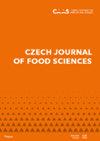FT-NIR光谱法在鱼片化学成分快速分析中的应用
IF 1
4区 农林科学
Q4 FOOD SCIENCE & TECHNOLOGY
引用次数: 0
摘要
研究了15种淡水和咸水鱼类肉的基本化学成分。采用傅里叶变换-近红外(FT-NIR)光谱法测定了鱼肉样品中脂肪、蛋白质和干物质的含量。干物质、脂肪和蛋白质含量差异显著(P < 0.05)。脂肪率最高的是鲤(Cyprinus carpio)(17.14±0.53%),最低的是鱼螺(Lophius piscatorius)(0.06±0.003%)。白鳍金枪鱼的蛋白质含量最高(24.26±1.89%),尼罗褐虾的蛋白质含量最低(14.73±0.87%)。干物质含量的测定结果从鲤鱼样品最高(35.73±0.47%)到鱼鳞虾样品最低(15.64±0.43%)。主成分分析(PCA)提取了三大类样品,根据样品的蛋白质、脂质和干物质含量对样品进行区分。偏最小二乘判别分析(PLSDA)证实了使用FT-NIR测量的三个变量(蛋白质、脂肪、干物质)来分离观察到的鱼类。本文章由计算机程序翻译,如有差异,请以英文原文为准。
Application of FT-NIR spectroscopy as a rapid tool for analysis of the fish fillet chemical composition
The basic chemical composition of the meat of fifteen freshwater and saltwater fish species was studied. Fourier transform-near-infrared (FT-NIR) spectroscopy was applied for determination of the content of fat, protein and dry matter in the fish meat samples. The fish species analysed differed significantly in dry matter, fat, and protein content (P < 0.05). The highest fat percentage was determined in the samples of Cyprinus carpio (17.14 ± 0.53%) and the lowest value was found in the samples of Lophius piscatorius (0.06 ± 0.003%). Thunnus albacares samples had the highest content of proteins (24.26 ± 1.89%), whereas the lowest protein content was observed in Oreochromis niloticus (14.73 ± 0.87%). The results of the measured dry matter varied from the highest content in C. carpio samples (35.73 ± 0.47%) to the lowest content of L. piscatorius samples (15.64 ± 0.43%). Principal component analysis (PCA) extracted three major groups, which differentiate the analysed samples based on their protein, lipid and dry matter content. Partial least squares discriminant analysis (PLSDA) confirmed the use of three variables (protein, fat, dry matter) measured by FT-NIR to separate the observed fish species.
求助全文
通过发布文献求助,成功后即可免费获取论文全文。
去求助
来源期刊

Czech Journal of Food Sciences
Food Science & Technology, Chemistry-食品科技
CiteScore
2.60
自引率
0.00%
发文量
48
审稿时长
7 months
期刊介绍:
Original research, critical review articles, and short communications dealing with food technology and processing (including food biochemistry, mikrobiology, analyse, engineering, nutrition and economy). Papers are published in English.
 求助内容:
求助内容: 应助结果提醒方式:
应助结果提醒方式:


